2004 PONTIAC BONNEVILLE wheel size
[x] Cancel search: wheel sizePage 340 of 446
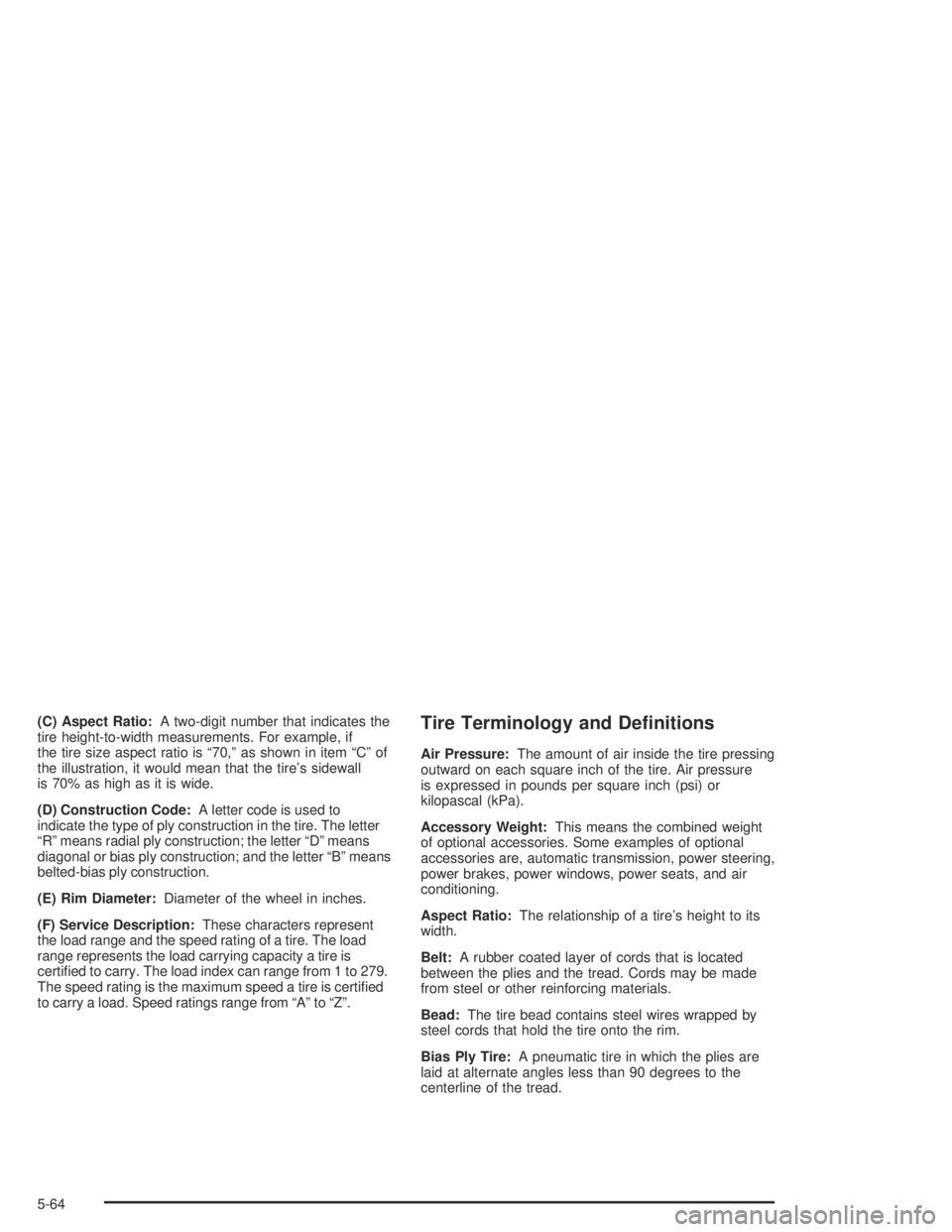
(C) Aspect Ratio:A two-digit number that indicates the
tire height-to-width measurements. For example, if
the tire size aspect ratio is “70,” as shown in item “C” of
the illustration, it would mean that the tire’s sidewall
is 70% as high as it is wide.
(D) Construction Code:A letter code is used to
indicate the type of ply construction in the tire. The letter
“R” means radial ply construction; the letter “D” means
diagonal or bias ply construction; and the letter “B” means
belted-bias ply construction.
(E) Rim Diameter:Diameter of the wheel in inches.
(F) Service Description:These characters represent
the load range and the speed rating of a tire. The load
range represents the load carrying capacity a tire is
certi�ed to carry. The load index can range from 1 to 279.
The speed rating is the maximum speed a tire is certi�ed
to carry a load. Speed ratings range from “A” to “Z”.Tire Terminology and De�nitions
Air Pressure:The amount of air inside the tire pressing
outward on each square inch of the tire. Air pressure
is expressed in pounds per square inch (psi) or
kilopascal (kPa).
Accessory Weight:This means the combined weight
of optional accessories. Some examples of optional
accessories are, automatic transmission, power steering,
power brakes, power windows, power seats, and air
conditioning.
Aspect Ratio:The relationship of a tire’s height to its
width.
Belt:A rubber coated layer of cords that is located
between the plies and the tread. Cords may be made
from steel or other reinforcing materials.
Bead:The tire bead contains steel wires wrapped by
steel cords that hold the tire onto the rim.
Bias Ply Tire:A pneumatic tire in which the plies are
laid at alternate angles less than 90 degrees to the
centerline of the tread.
5-64
Page 349 of 446
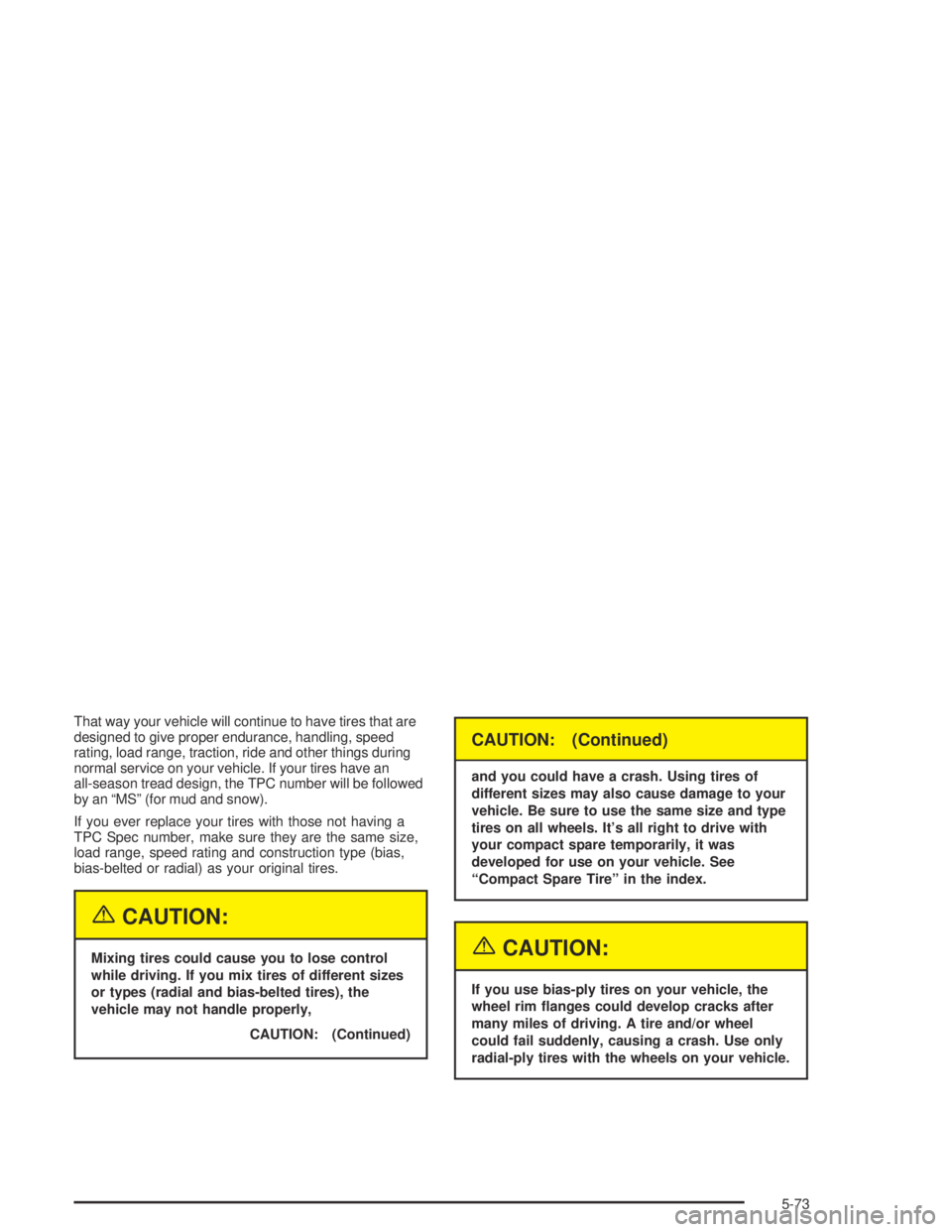
That way your vehicle will continue to have tires that are
designed to give proper endurance, handling, speed
rating, load range, traction, ride and other things during
normal service on your vehicle. If your tires have an
all-season tread design, the TPC number will be followed
by an “MS” (for mud and snow).
If you ever replace your tires with those not having a
TPC Spec number, make sure they are the same size,
load range, speed rating and construction type (bias,
bias-belted or radial) as your original tires.
{CAUTION:
Mixing tires could cause you to lose control
while driving. If you mix tires of different sizes
or types (radial and bias-belted tires), the
vehicle may not handle properly,
CAUTION: (Continued)
CAUTION: (Continued)
and you could have a crash. Using tires of
different sizes may also cause damage to your
vehicle. Be sure to use the same size and type
tires on all wheels. It’s all right to drive with
your compact spare temporarily, it was
developed for use on your vehicle. See
“Compact Spare Tire” in the index.
{CAUTION:
If you use bias-ply tires on your vehicle, the
wheel rim �anges could develop cracks after
many miles of driving. A tire and/or wheel
could fail suddenly, causing a crash. Use only
radial-ply tires with the wheels on your vehicle.
5-73
Page 353 of 446
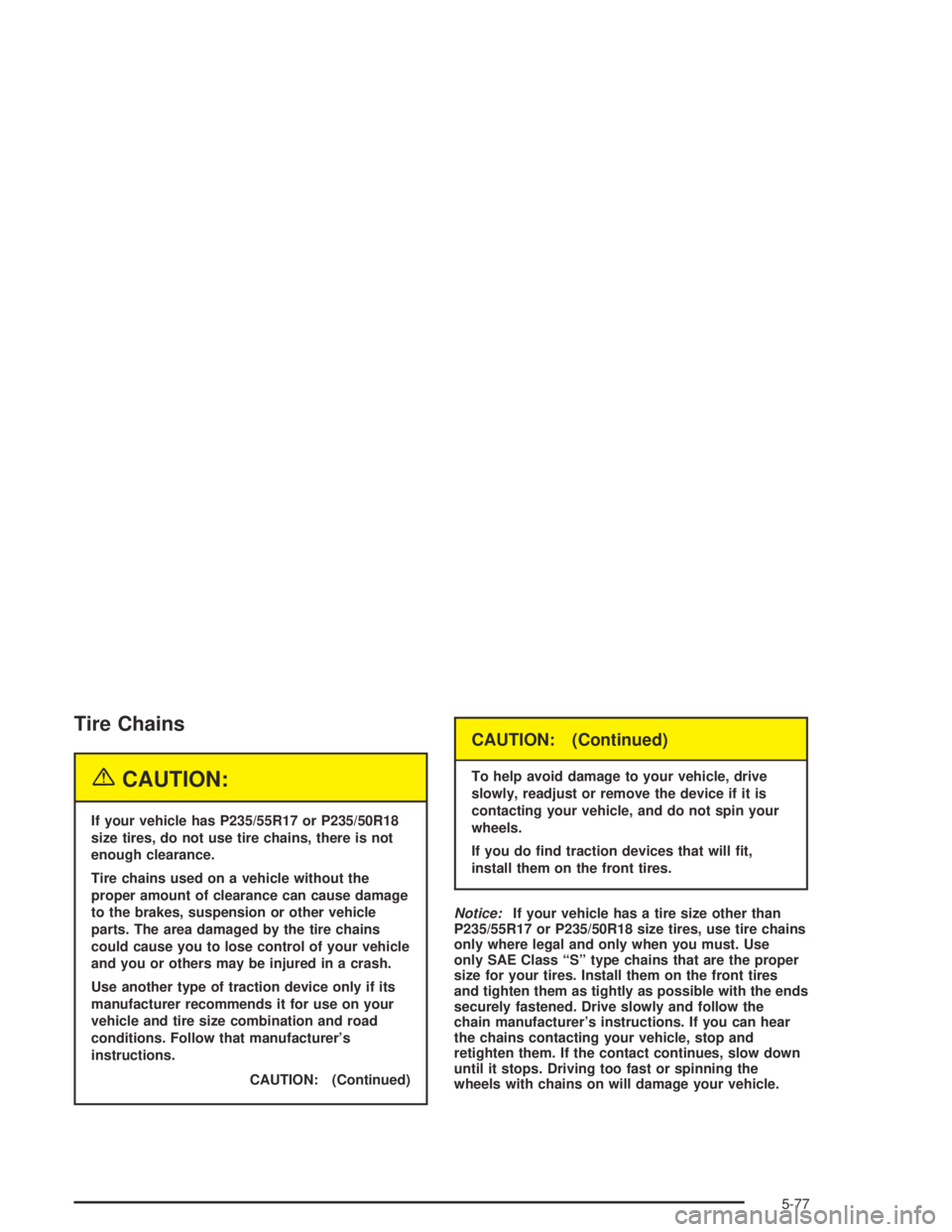
Tire Chains
{CAUTION:
If your vehicle has P235/55R17 or P235/50R18
size tires, do not use tire chains, there is not
enough clearance.
Tire chains used on a vehicle without the
proper amount of clearance can cause damage
to the brakes, suspension or other vehicle
parts. The area damaged by the tire chains
could cause you to lose control of your vehicle
and you or others may be injured in a crash.
Use another type of traction device only if its
manufacturer recommends it for use on your
vehicle and tire size combination and road
conditions. Follow that manufacturer’s
instructions.
CAUTION: (Continued)
CAUTION: (Continued)
To help avoid damage to your vehicle, drive
slowly, readjust or remove the device if it is
contacting your vehicle, and do not spin your
wheels.
If you do �nd traction devices that will �t,
install them on the front tires.
Notice:If your vehicle has a tire size other than
P235/55R17 or P235/50R18 size tires, use tire chains
only where legal and only when you must. Use
only SAE Class “S” type chains that are the proper
size for your tires. Install them on the front tires
and tighten them as tightly as possible with the ends
securely fastened. Drive slowly and follow the
chain manufacturer’s instructions. If you can hear
the chains contacting your vehicle, stop and
retighten them. If the contact continues, slow down
until it stops. Driving too fast or spinning the
wheels with chains on will damage your vehicle.
5-77
Page 364 of 446
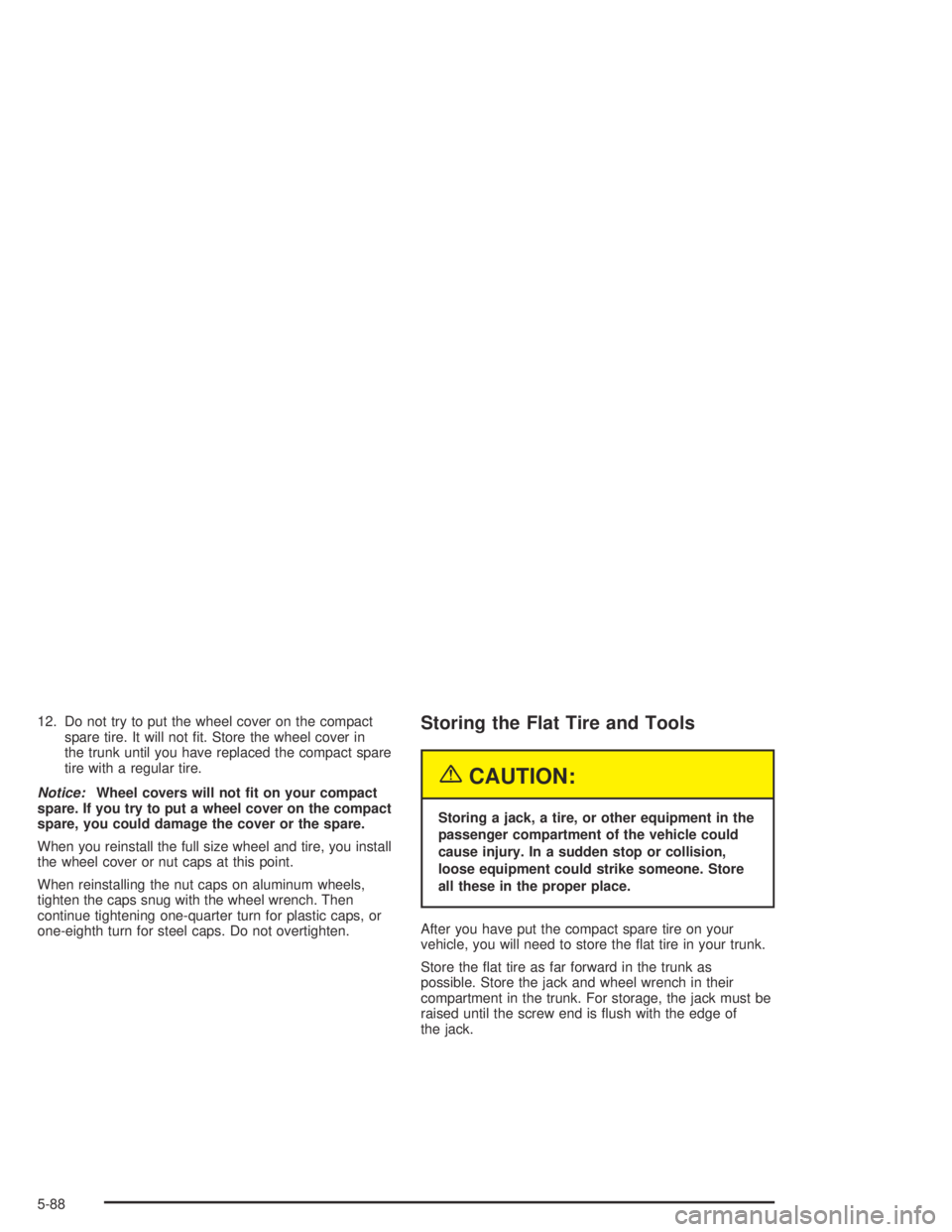
12. Do not try to put the wheel cover on the compact
spare tire. It will not �t. Store the wheel cover in
the trunk until you have replaced the compact spare
tire with a regular tire.
Notice:Wheel covers will not �t on your compact
spare. If you try to put a wheel cover on the compact
spare, you could damage the cover or the spare.
When you reinstall the full size wheel and tire, you install
the wheel cover or nut caps at this point.
When reinstalling the nut caps on aluminum wheels,
tighten the caps snug with the wheel wrench. Then
continue tightening one-quarter turn for plastic caps, or
one-eighth turn for steel caps. Do not overtighten.Storing the Flat Tire and Tools
{CAUTION:
Storing a jack, a tire, or other equipment in the
passenger compartment of the vehicle could
cause injury. In a sudden stop or collision,
loose equipment could strike someone. Store
all these in the proper place.
After you have put the compact spare tire on your
vehicle, you will need to store the �at tire in your trunk.
Store the �at tire as far forward in the trunk as
possible. Store the jack and wheel wrench in their
compartment in the trunk. For storage, the jack must be
raised until the screw end is �ush with the edge of
the jack.
5-88
Page 366 of 446
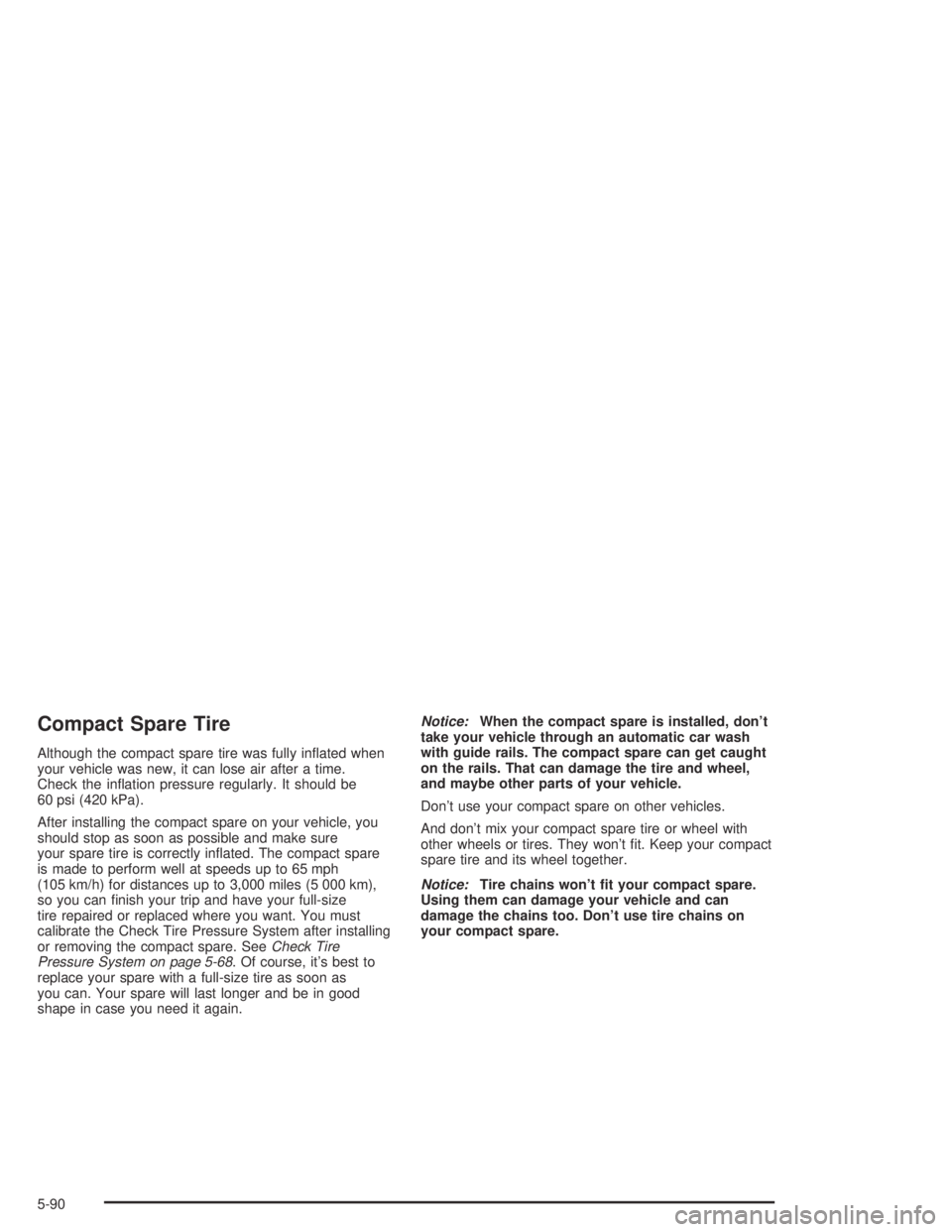
Compact Spare Tire
Although the compact spare tire was fully in�ated when
your vehicle was new, it can lose air after a time.
Check the in�ation pressure regularly. It should be
60 psi (420 kPa).
After installing the compact spare on your vehicle, you
should stop as soon as possible and make sure
your spare tire is correctly in�ated. The compact spare
is made to perform well at speeds up to 65 mph
(105 km/h) for distances up to 3,000 miles (5 000 km),
so you can �nish your trip and have your full-size
tire repaired or replaced where you want. You must
calibrate the Check Tire Pressure System after installing
or removing the compact spare. SeeCheck Tire
Pressure System on page 5-68. Of course, it’s best to
replace your spare with a full-size tire as soon as
you can. Your spare will last longer and be in good
shape in case you need it again.Notice:When the compact spare is installed, don’t
take your vehicle through an automatic car wash
with guide rails. The compact spare can get caught
on the rails. That can damage the tire and wheel,
and maybe other parts of your vehicle.
Don’t use your compact spare on other vehicles.
And don’t mix your compact spare tire or wheel with
other wheels or tires. They won’t �t. Keep your compact
spare tire and its wheel together.
Notice:Tire chains won’t �t your compact spare.
Using them can damage your vehicle and can
damage the chains too. Don’t use tire chains on
your compact spare.
5-90
Page 444 of 446

T
Tachometer....................................................3-40
Taillamps
Turn Signal, Stoplamps and Back-up Lamps......5-56
TCS Warning Light..........................................3-45
Testing the Alarm............................................2-22
Theater Dimming............................................3-19
Theft-Deterrent, Radio....................................3-105
Theft-Deterrent Systems...................................2-21
Content Theft-Deterrent................................2-22
PASS-Key
®III .............................................2-23
PASS-Key®III Operation..............................2-23
Universal Theft-Deterrent..............................2-21
Throttle System Inspection...............................6-24
Tilt Wheel........................................................ 3-7
Tire
Pressure Light.............................................3-48
Tire In�ation Check.........................................6-19
Tire Sidewall Labeling......................................5-59
Tire Size.......................................................5-63
Tire Terminology and De�nitions........................5-64
Tires.............................................................5-58
Buying New Tires........................................5-72
Chains.......................................................5-77
Changing a Flat Tire....................................5-80
Check Tire Pressure System.........................5-68
Compact Spare Tire.....................................5-90
If a Tire Goes Flat.......................................5-79
In�ation - Tire Pressure................................5-67Tires (cont.)
Inspection and Rotation................................5-70
Uniform Tire Quality Grading.........................5-74
Wheel Alignment and Tire Balance.................5-75
Wheel Replacement.....................................5-75
When It Is Time for New Tires......................5-72
To Use the Engine Coolant Heater....................2-28
Top Strap......................................................1-40
Top Strap Anchor Location...............................1-41
Torque Lock...................................................2-35
Total Weight on Your Vehicle’s Tires..................4-42
Towing
Recreational Vehicle.....................................4-31
Towing a Trailer..........................................4-39
Your Vehicle...............................................4-31
Traction
Control System (TCS).................................... 4-9
Control System Warning Light.......................3-45
Low Active Light..........................................3-46
Trailer Brakes.................................................4-42
Trailer Wiring Harness.....................................4-42
Transaxle
Fluid, Automatic...........................................5-23
Transaxle Operation, Automatic.........................2-29
Transmission, Transaxle, Transfer Case Unit
Repair Manual............................................7-12
Transportation Options...................................... 7-8
Trip Odometer................................................3-39
Trunk............................................................2-16
Trunk Ajar Light..............................................3-55
14